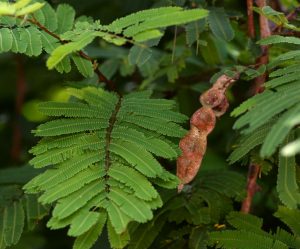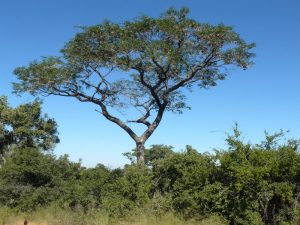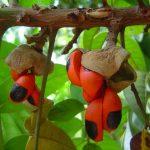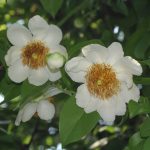TREE LIFE
November 1988
HARARE CALENDAR
Tuesday 1st November : Botanic Garden Walk. Meet in the Car Park at 1645 for 1700 hours.
Sunday 20th November : An outing to the Botanic Garden Extension at Christon Bank
This is a site we have visited before and on each occasion still come away with a deep satisfaction, with the rich diversity of vegetation so remarkably close to Harare. On this occasion it is intended that we explore some of the less commonly frequented corners of the Extension, and hopefully this may avoid too many ascents and descents.
Please get onto the phone to share lifts in own cars, as a bus would certainly be uneconomical for such a relatively short distance. Meet at the venue at 1000hours.
Saturday 26th November : The last Mukuvisi Woodland walk of the year. Meet at 1500 hours at the Paget Road/Inyanga Crescent gate.
Sunday 11th December : Our informal pre-Christmas gathering in lieu of outing. Probably at Chairman Dick Hicks’ Monavale garden. Details in next Tree Life.
Sunday 25th December : Merry Christmas
Sunday 1st January 1989 : Happy New Year
Sunday 15th January 1989 : Alan and Helen Foot’s Trianda Farm, Old Mazowe Road
MATABELELAND CALENDAR
On Sunday, 6th November we have been invited to Mr. Philip Capon’s “Maldon Farm” in the Thaba Sinduna area
On Sunday 4th December we hope to visit Mike Chennel’s “Rennydene Farm” –
MATABELELAND NOTES
We decided to visit a Kalahari sand area for our meeting on Sunday 2nd October. Although there is never a large number of species, and leaves were absent on many, we wanted our newer members to study them.

Acacia ataxacantha. Photo: Bart Wursten. Source: Flora of Zimbabwe.
Acacia ataxacantha was widespread on the exposed sand area – the thorns even over shadowed those of Zizyphus mucronata; A .karroo with spines of 7 cm, A. nigrescens in flower, A. rehmanniana with very red branches and A. robusta were there. Baikea plurijuga were in full leaf, still with some velvety pods and were alongside Burkea africana which were festooned with catkins and Bolusanthus speciosus in flower. We saw Cassine matabelica and Dichrosyachys cinerea.
Colophospermum mopane was very sparse, which was worrying the owner of the farm (Mopane Farm) – presumably affected by years of drought on the loose Kalahari sand. The combretums were not yet in leaf but we identified Combretum collinum, C. hereroense, C. zeyheri by the size of flowers and their old seed pods (C. zeyheri 7cm) and C. molle and C. imberbe by the bark. Carissa bispinosa var. bispinosa had copy book Y-shaped thorns up to 4.5cm long. No C. edulis were observed. Diospyros lycioides were plentiful, also Euclea crispa, E. undata and E. divinorum. We found two Erythroxylum capense, Grewia flavescens and G. retinervis; Lannea discolour were coming into leaf and Maytenus senegalensis had very large leaves. Ochna pulchra, peeling bark ochna, were strikingly green in the drought stricken landscape and had sprays of tiny orchid like green flowers and were flanked by Securidaca longepedunculata covered in their violet flowers. There were Osyris lanceolata, Pappea capensis, Pterocarpus angolensis in flower, and coming into leaf were Peltophorum africanum and Sclerocarya birrea. There were many small Strychnos pungens and also S. cocculoides with their corky bark. Terminalia sericea covered one area in a silver sheen, and along the airport road outside the farm boundary were Ricinodendron rantanenii coming into leaf.
Betty Blake
THE MACKERSIE’S FARM, MATEPATEPA : 16TH October, 1988
It is a long drive to Matepatepa. We stopped for oranges at Mazowe and turned north at Bindura, dropping down into broken countryside. Although the bush is dry at Bindura, Barbara’s garden is an emerald oasis with splodges of colour. Jemima’s delight at the magnificent loo with wooden seat was surpassed by the general enthusiasm towards fresh tea and nibbles. A change of transport to a truck and Landover added excitement, especially when four ladies were attacked by a garden bench that closed in on them with every bump.
The morning walk through an old field abandoned 23 years ago ago showed remarkable regeneration. In general trees were more crowded than in a mature woodland, with older trees confined to granite boulders and the edges of the old fields. Dodonaea viscosa typically invades disturbed areas and had colonised an abandoned roadway. Combretum fragrens, another early succession species, was in fresh green leaf. A number of specimens had opposite leaves instead of whorls of three or four. When this occurs they resemble C. apiculatum which also has a varnished shine, apiculate tip and 3D veins that run parallel like the rungs of a ladder. We should have used a slash test as the under bark of C. apiculatum is a distinct yellow. Uapaca kirkiana formed a dense stand which indicated a frost free area. The female trees were in full fruit, as were the Uapaca nitida nearby. We were able to compare the hard growing tips on both these species.
We were able to compare the effect of traditional healers on three tree species,

Pterocarpus angolensis. Source: Plantinfo
Pterocarpus angolensis, Garcinia buchananii and Ozoroa insignis. The under bark of the mukwa, P. angolensis, has many resin canals that exude a blood red sap. This exudate is most impressive when one examines a box full of bark in the dim light of a healer’s room, the red gum sets into lumps and scabs. I have seen it used as a cure for bilharzia but consultation with the tome indicates that is more commonly used for diarrhoea, menorrhagia, backache and depressed fontanels. Depression of the fontanels in infants often results from dehydration, as this is considered the weakest part of an infant’s body it is often protected by applying a tarry mixture that may originate from mukwa and Dichrostachys cinerea (either the root or the fruit). It was interesting to note how well the bark on the mukwa had been collected. Four neat scars which had healed well were all that remained of previous cell sections and the two fresh scars were sealed with resin although the bark had not began to grow. All samples had been removed from the same height – 1.5m.
The second tree whose bark had been harvested was Garcinia buchananii. In this case the trunks had been damaged extensively and were often completely ring barked. Six stems were examined, all of which were covered in female flowers. Male flowers which may occur on the same or on different trees, were not seen and the undamaged specimens had no flowers. This bark is used as an aphrodisiac (usually for men) and when powdered, mixed with Vaseline and inserted into the vagina is said to reduce its diameter. Once again this tree has a striking bark that exudes a colourful resin, this time a bright yellow colour.
Ozoroa insignis does not have a coloured resin but it belongs to the ANACARDIACEAE, a family with resin canals (remember the resinous smell we use to distinguish Rhus). Although I had thought that the bark was an aphrodisiac this is wrong, the root is the aphrodisiac, the bark is used to cure V.D. (now known as STD). This bark had been harvested in long strips but leaving enough for the tree to survive.
One of the rarest sights for the day was a pennant-winged nightjar adorned with flowing pennants. It flew up from the ground a few feet from the general mass of botanizers. Another new sight were the small yellow flowers on a bushy tree. Careful examination revealed six petals in two whorls – an ANNONACEAE. Careful searching led to the leaf of Hexalobus monopetalus. Petals in whorls of 3 is unusual in a plant with net veined leaves, amongst the Zimbabwean trees it really only occur in the ANNONACEAE. Fruit that is divided into 3’s or 6’s usually indicates EUPHORBIACEAE.
A rare sight for the folk from Harare was Diospyros kirkii with one tree in fresh new leaf, another in old leaf and a third in green fruit. The young leaves are very hairy and may be slightly pink, if one uses a lot of imagination. The shona name mushenje applies both to this and D. mespiliformis. This may explain why Richard’s 4 nostrilled giraffe made from mushenje is pale white, although the wood is very dense. The heart wood of D. mespiliformis is dark, more like what we expect of an ebony. These two species do form hybrids.
After a shady lunch augmented with further culinary delights by Barbara, we set out along a stream. Here we were able to indulge in eating Carissa edulis. The ripe black berries are exciting because as one bites into the red flesh the thick white milk which is characteristic of the APOCYNACEAE runs out, almost curdling with the red juice. This surrealistic display contrasts with the refreshing taste. I have never seen Diospyros lycioides in such prolific flower but I think the folk learned a lot more from actually seeing a lemon tree that had escaped from captivity than we have in seeing all the RUTACEAE together. I often assume that everyone has pulled leaves off lemon trees and examined their dots and smelt their smell – apparently not. It was also good to see the slightly winged petiole characteristic of many RUTACEAE.
Yet another cup of tea and another look at the colourful garden before we reboarded the bus and set off home again. Many thanks to Barbara Mackersie and her son, John, as well as Ian Taylor who helped with the transport.
FLAMES OF CONTROVERSY
VISITORS TO THE UNITED STATES NATIONAL PARKS HAVE A DUTY TO PREVENT FOREST FIRES. SOME SCIENTISTS BELIEVE IT IS A RANGER’S DUTY TO START THEM. JO HAGGERTY
The forest fills with the roar and crackling of burning wood. Orange flames blacken a stand of rare, giant sequoia trees as the forest fire races towards a nearby meadow. A park ranger waits patiently for the fire to reach the meadow and burn itself out. In her hand is the incendiary device she used to light the fire.
The scene would horrify most Americans who have been taught since an early age to prevent forest fires. There were good reasons for this. The number of tourists in the areas of wilderness in the US rose dramatically during the 1950’s. They caused large numbers of forest fires, destroying vast areas of valuable timber.
To fight the menace the US Forest Service launched an intensive campaign to make people more careful with fire in forests. The campaign spawned one of the most successful advertising gimmicks ever; the cartoon character, Smokey Bear. With his shovel, ranger’s hat and injection to “Remember, only YOU can prevent forest fires” Smokey firmly fixed in the American mind the conviction that forest fires are bad.
But scientists have since discovered that forests, which evolved to deal with regular fires caused by lightning, need to be burned occasionally to remain healthy. American forestry officials are now having to persuade the public that some forest fires are good.
Not everyone is convinced. Forest fires are terrifying while they are happening and leave ugly scars. They are not nearly as easy to sell to the public as Smokey Bear. This year, as American suffers from a severe drought, the issue of deliberate forest fires has blazed into public awareness. Politicians are now pitted against foresters in a misplaced effort to save trees that could eventually destroy many American forests.
Patti Haggerty, a fire monitor at Sequoia National Park, California, explains the history of the debate: “From the early years of the Parks Service in the last century to around 1968, it had been policy to quench all fires that started on park lands whether the fire was man-made or natural lightning fire. This lack of fire for 80 years or so in areas that usually burned on the average every seven to ten years, has allowed huge amounts of underbrush and fallen trees to develop beneath existing stands of trees. If a fire were to catch in these regions it would burn very hot and would destroy even the very large trees. Control burning is used to keep this from happening.”
Once a forest area is designated for a control, or prescribed, fire, some of the larger fallen trees are removed and smaller trees cut down. This will prevent the fire from burning too hot and getting out of control.
The first controlled fires in Sequoia National Park took place in 1968, but the idea is far from new. In 1891 early settlers in the Sequoia region proudly claimed that they had saved a grove of sequoias from burning 29 times in just five years. Gifford Pinchot, the director of the Forest Service at the time, responded “Who then saved them during the remaining three or four thousand years of their age?”
Pinchot, though clearly ahead of his time, had no authority to set a fire policy for the national parks, which are separate from the Forest Service. The purpose of the parks was to serve the people and blackened forest did little in this regard. So a strong programme of defence against forest fires was part of every park director’s policy until the 1960’s, when the Parks Service changed its thinking. In 1963 a commission that came to be known as the Leopold panel proposed that the decades of stopping and preventing fires in forests may have caused much more harm than good.
The panel made two recommendations. The first was that park and forest officials should begin controlled fires to restore the levels of fuel in the forest to those of the last century. The second recommendation was to allow fires caused by lightning to burn without interference until they either burned themselves out or threatened human life, buildings, or private property. This report started the rethink of fire policy in America.
Fire is now considered by most people charged with managing wilderness areas as a natural process that serves a vital ecological purpose within a forest. Most parks now let natural fires burn whenever possible, and they also use some controlled burning.
Fire is no longer considered the harbinger of destruction that it once was. Some would say it is nature’s cleaning process; ridding the forest floor of years of debris. This debris hinders the growth of new trees and, it accumulates in large enough quantities, leads to large, uncontrollable crown fires. These fires reach the tops of the trees and can damage a forest severely. It may take decades for a forest to recover from a crown fire and the area is very susceptible to erosion in the meantime.
Most fires do not reach the crowns of the trees, however, and they actually help to prevent such catastrophic burns. Most kill only smaller trees and shrubs and allow seedlings from the larger trees to germinate. Most large tree species cannot thrive in the shade and do not grow well under heavy undergrowth. Without occasional fires to clear this undergrowth, fewer of the larger trees will grow.
The most striking example of a species which is dependent on fires is the

Sequoiadendron giganteum or giant sequoia. This majestic tree once grew almost everywhere in North America but now can be found only in a few small pockets in the Sierra Nevada of California.
The sequoia is the world’s largest living thing and is well adapted to environments where forest fires are common. The bark of the huge tree is often up to 30 centimetres thick and insulates the tree from the heat of a fire. This bark chars very easily but the tree is undamaged in most cases.
Fire is vital to the reproduction of sequoias. The cones of the trees are serotinous, which means they remain closed after maturing and may stay that way for up to 20 years. The heat of the fire often opens these cones and the seeds fall onto the forest floor at several times the normal rate in the days after the fire. The scorched ground is ideal for sequoia seeds to germinate because it is free of the fungi which kill the seeds and it has a high mineral content.
The effect of a forest fire on the germination of sequoia seeds is profound as Haggerty explains “If you go into a sequoia grove where fires have been suppressed for a long time, you will see very few young sequoia trees; if any at all. However, just a few months after a fire, there are sequoia seedlings cropping up by the hundreds. But the mortality rate of young sequoia seedlings is however, very high.”
One of the main jobs of those like Haggerty who manage fires is to decide when to light a controlled burn. They use computers to help to determine when to burn an area. The calculations are based on the amounts of, among other things, woody debris, soil, organic matter and moisture in the area. Weather conditions are also included. The computer is also used to predict the model fuel dynamics as well as the behaviour of the fire.
Most controlled fires take place in regions with relatively high populations of residents and visitors. This is because these areas must be well protected from catastrophic fires and controlled burning reduces the risk. In the process it creates a healthier forest but gives the appearance of utter destruction.
Because of their position the fires draw a lot of attention. Public perception is perhaps the biggest problem facing those who use prescribed burning to manage the forests. Smokey Bear is practically a national institution and forestry officials admit it will take a long time to teach the public that fires can be good for a forest.
Television and newspapers still treat fires in a generally negative manner. Smokey Bear is still not obsolete. His purpose has always been to deter the public from starting forest fires. Such fires tend to be the most damaging to property and to human life because they are almost always started in relatively densely inhabited areas.
The second major recommendation of the Leopold panel has resulted in the “let it burn” policy towards natural fires. The Parks Service supports this approach but it has created problems for staff. In many areas there is a century’s worth of undergrowth. It would be very difficult for the service to start a controlled fire without the risk of huge destructive blazes, harmful to both humans and forest. The transition back to an environment in which fires are natural will not be easy.
Another major problem is that of fires crossing park boundaries. Wilderness areas in the US are owned by several different government agencies. Besides the Park Service and the Forest Service, the Bureau of Land Management owns millions of hectares of wilderness and there are numerous state-owned parks and forests.
The let it burn policy requires a lot of communication between these agencies to ensure that fires do not get out of hand. To date that communication does not exist and to any great degree. No one yet knows who is responsible for a prescribed fired that gets out of control and destroys property on private land because it has not yet happened although it remains a potentially serious problem.
The fires this summer, especially those that threatened the historic Old Faithful Lodge in Yellowstone National Park, Wyoming, have highlighted the conflict between the public’s interests and the park’s fire policy. The high levels fuel coupled with intense heat and drought, brought an unprecedented risk of fire. The let-it-burn policy is getting its first full public scrutiny as newspapers bring coverage of fires to the front page.
The pressure on park and forest management has been especially intense in the Yellowstone area. Many people there make their living as guides for hunting and rafting excursions. These people say that the fires are keeping visitors out of the forest and are ruining their businesses. In addition, coverage on national television has given the impression that the whole of Yellowstone Park is going up in flames. Such media attention has sparked public outcries over why the Parks Service is not doing anything about it. The matter was finally taken out of the hands of Yellowstone officials when Don Hodel, the Secretary of the Interior, whose department runs the Parks Service, decided that, for the time being, all further fires in the park should be quenched and that the let-it-burn policy would be re-examined.
The drought in the US has put prescribed fires and the let-it-burn policy on hold. Many foresters, however, feel it would be wrong to back down from the policies in the face of media attention.
Most people who have to deal with forest fires believe that public education about the benefits of fire will turn popular opinion. Bob Barbee, Yellowstone’s superintendent says “Charred forests are hard to sell. Right now it looks like a war took place. But in a few years, it will be a carpet of new growth”.
During the fires at Yellowstone Park workers handed out notes to visitors stating that they were lucky to witness this natural event but the visitors were still shocked by the destructive power of the fires.
Haggerty agrees that the sight of a burned forest can be quite appalling. Indeed there are some who are opposed to the programme of controlled fires in sequoia groves for this very reason. However, most feel that the fire policies of the Parks Service will continue despite the objections. As Haggarty put it “For the sake of the big trees, hopefully cooler heads will prevail.”
With acknowledgements to New Scientist, 25th August, 1988.
Joe Haggerty is a freelance science writer based in Carisbad, California
DICK HICKS CHAIRMAN



